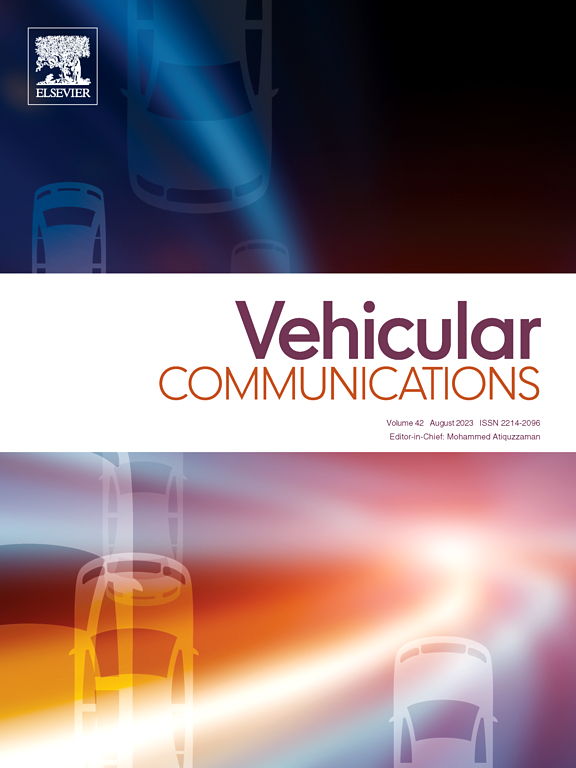Cognitive UAV-assisted secure and reliable communications based on robust joint trajectory and power control optimization
IF 6.5
2区 计算机科学
Q1 TELECOMMUNICATIONS
引用次数: 0
Abstract
The cognitive unmanned aerial vehicle (UAV) communication system has emerged as a pivotal technology in addressing the scarcity of spectral resources for UAV communications, but the jamming and eavesdropping attacks are severe due to the high-quality air-to-ground communication links. Consequently, this paper introduces a UAV-enabled cooperative jammer to disrupt the eavesdropping activities of active eavesdroppers by emitting artificial noise. Our objective is to jointly optimize the three-dimensional UAV trajectory and transmit power to maximize the secrecy communication rate under quality of service (QoS) requirement. To tackle the non-convex problem, the block coordinate descent (BCD) and successive convex approximation (SCA) methods are utilized to transform it into an approximate convex problem, and then we design an alternative optimization iterative algorithm to achieve suboptimal but efficient solution. Moreover, we extend the developed algorithm into an imperfect channel state information (CSI) scenario to maximize the worst-case secrecy rate by jointly optimizing the robust UAV's trajectory and transmit power, where the location uncertainties of ground primary, secondary, and eavesdropping devices are considered. Simulation results demonstrate that the proposed joint optimization algorithm significantly enhances system secrecy performance under different real-world settings compared to existing state-of-the-art algorithms.
基于鲁棒关节轨迹和功率控制优化的认知无人机辅助安全可靠通信
认知型无人机通信系统已成为解决无人机通信频谱资源短缺的关键技术,但由于高质量的空对地通信链路,干扰和窃听攻击严重。因此,本文引入了一种无人机协同干扰机,通过发射人工噪声来干扰主动窃听者的窃听活动。我们的目标是在满足服务质量(QoS)要求的情况下,共同优化三维无人机的弹道和发射功率,使保密通信速率最大化。针对非凸问题,利用分块坐标下降法(BCD)和逐次凸逼近法(SCA)将其转化为近似凸问题,然后设计了一种替代优化迭代算法,以获得次优但有效的解。此外,我们将所开发的算法扩展到不完全信道状态信息(CSI)场景中,通过联合优化鲁棒无人机的轨迹和发射功率来最大化最坏情况下的保密率,其中考虑了地面主、次和窃听设备的位置不确定性。仿真结果表明,与现有的先进算法相比,所提出的联合优化算法显著提高了系统在不同现实环境下的保密性能。
本文章由计算机程序翻译,如有差异,请以英文原文为准。
求助全文
约1分钟内获得全文
求助全文
来源期刊

Vehicular Communications
Engineering-Electrical and Electronic Engineering
CiteScore
12.70
自引率
10.40%
发文量
88
审稿时长
62 days
期刊介绍:
Vehicular communications is a growing area of communications between vehicles and including roadside communication infrastructure. Advances in wireless communications are making possible sharing of information through real time communications between vehicles and infrastructure. This has led to applications to increase safety of vehicles and communication between passengers and the Internet. Standardization efforts on vehicular communication are also underway to make vehicular transportation safer, greener and easier.
The aim of the journal is to publish high quality peer–reviewed papers in the area of vehicular communications. The scope encompasses all types of communications involving vehicles, including vehicle–to–vehicle and vehicle–to–infrastructure. The scope includes (but not limited to) the following topics related to vehicular communications:
Vehicle to vehicle and vehicle to infrastructure communications
Channel modelling, modulating and coding
Congestion Control and scalability issues
Protocol design, testing and verification
Routing in vehicular networks
Security issues and countermeasures
Deployment and field testing
Reducing energy consumption and enhancing safety of vehicles
Wireless in–car networks
Data collection and dissemination methods
Mobility and handover issues
Safety and driver assistance applications
UAV
Underwater communications
Autonomous cooperative driving
Social networks
Internet of vehicles
Standardization of protocols.
 求助内容:
求助内容: 应助结果提醒方式:
应助结果提醒方式:


